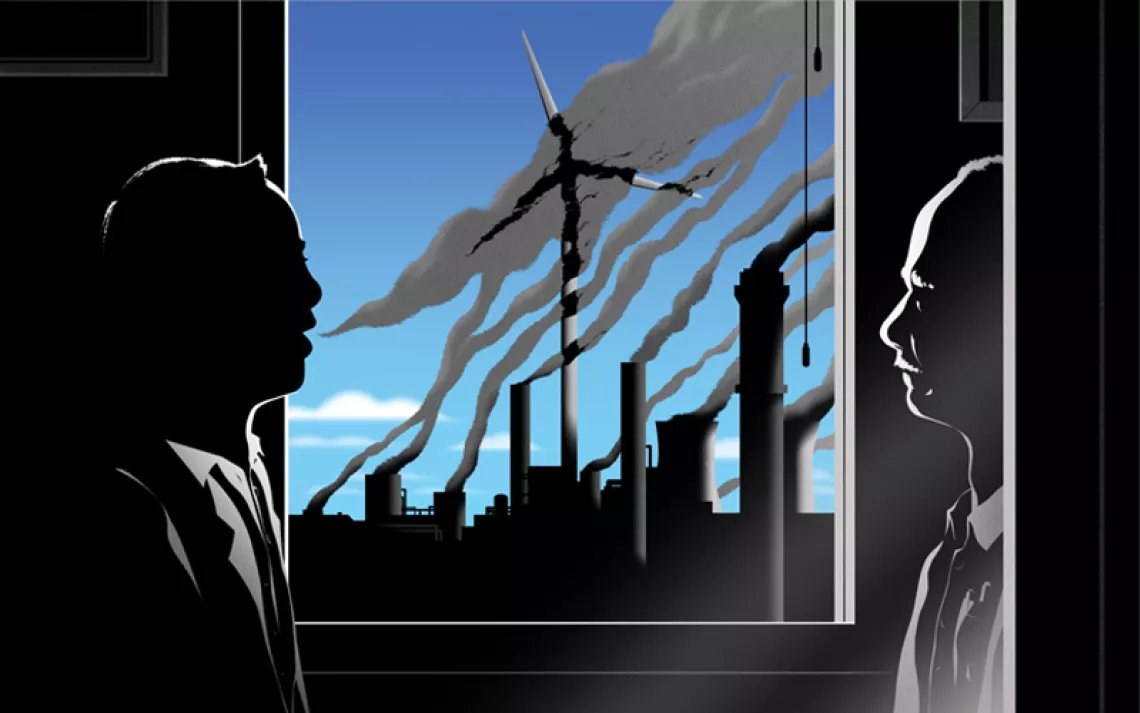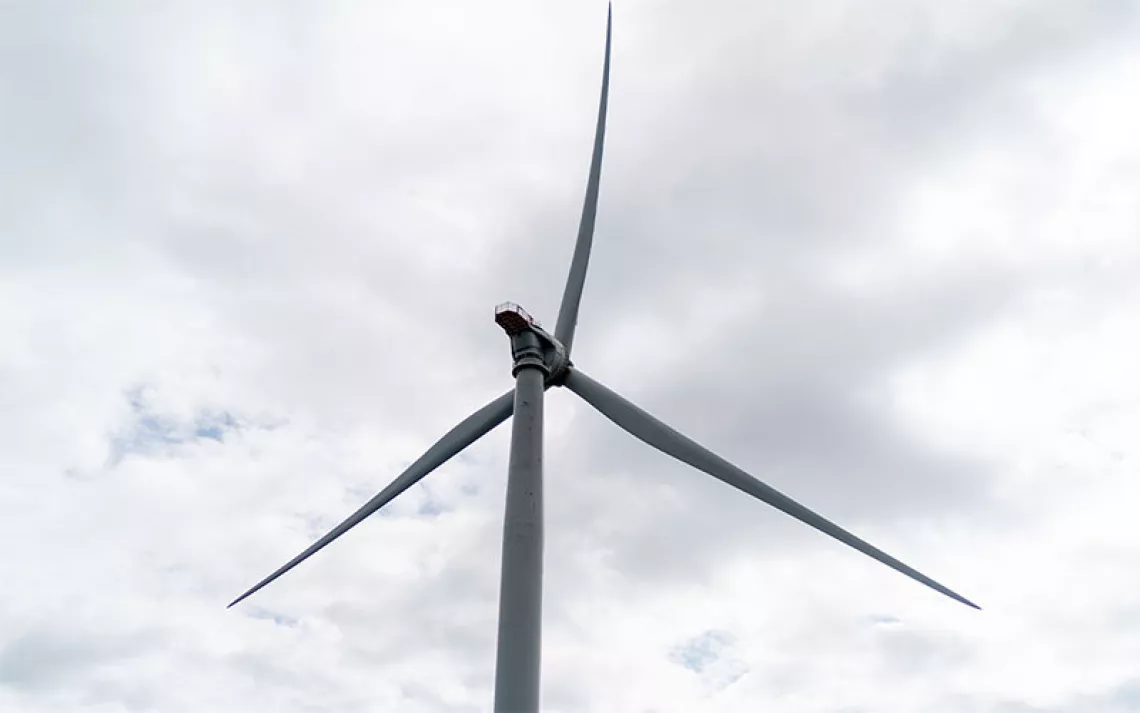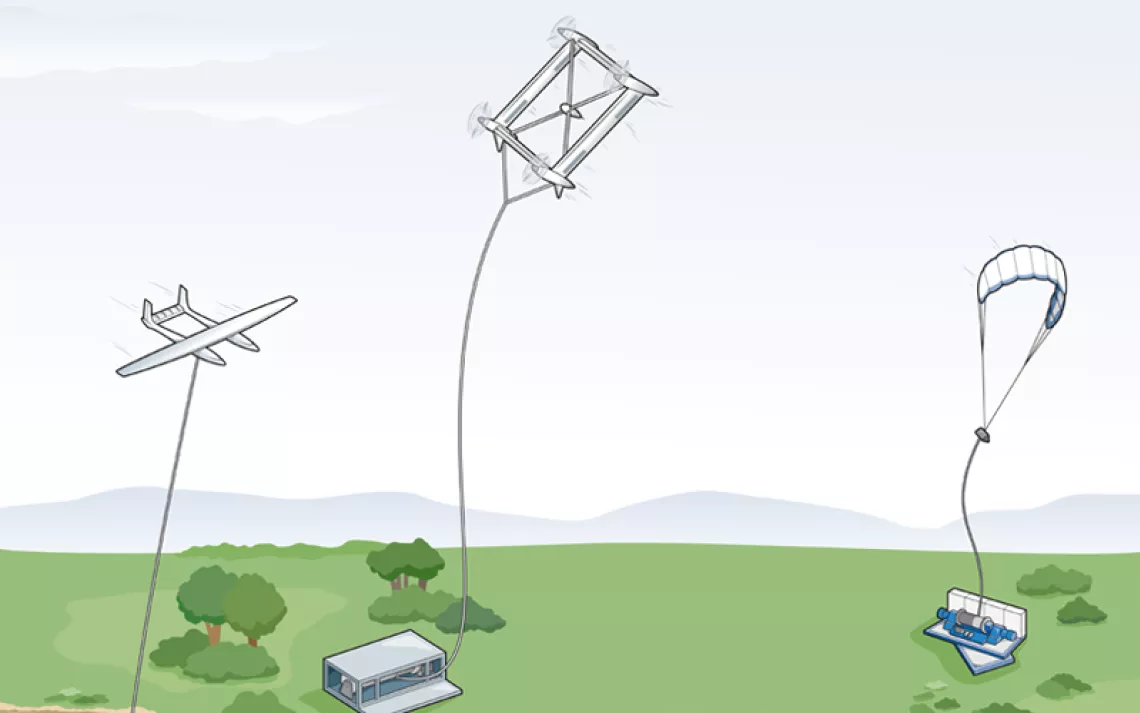Floating Wind Turbines Could Power the West Coast
A wind farm using promising new technology is proposed for deep ocean off the California coast
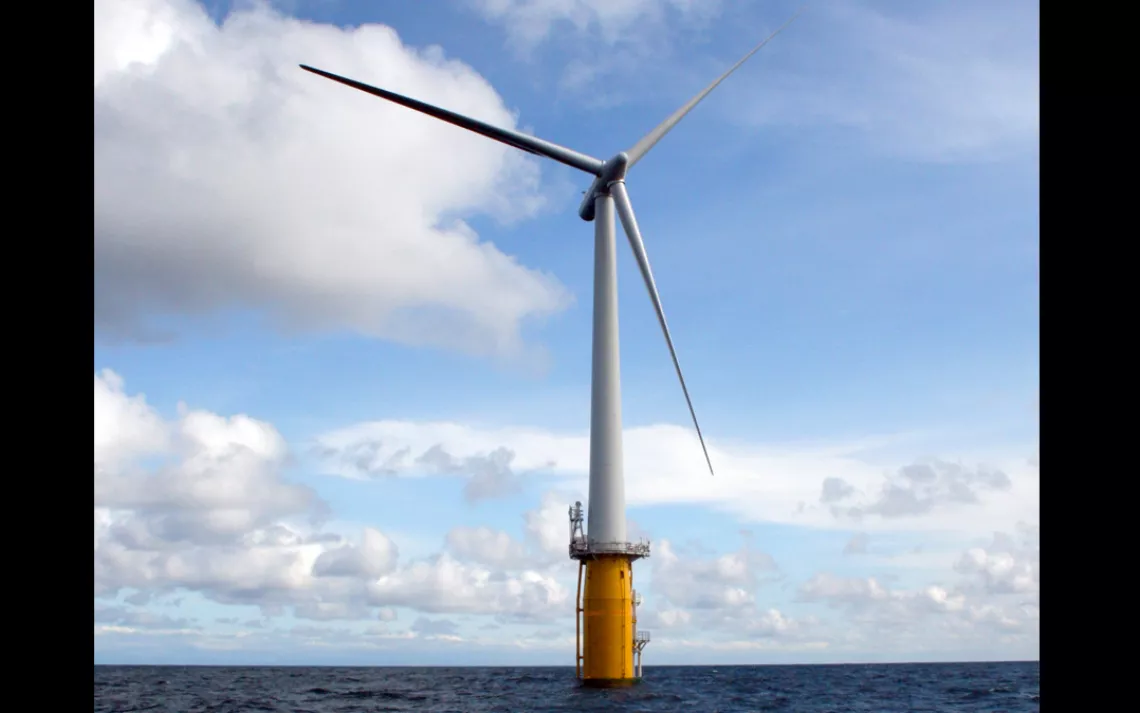
Hywind's floating turbine in sea trials off Scotland | Photo by Trude Refsahl - Statoil
Martha's Vineyard, it turns out, wasn't the best place to launch the first offshore wind farm in the United States. Back in 2001, when Cape Wind Associates proposed installing 130 wind turbines across the Horseshoe Shoal, it cited the abundant renewable energy the installation would deliver to tens of thousands of homes. Those turbines, however, would have stood within sight of those same communities, which include popular tourist districts and the private compounds of the Koch brothers and the Kennedys. The issue of wind-turbine visibility is a peculiar one—after all, there are plenty of highly visible coal, nuclear, and solar facilities, compared to which wind turbines have a certain majestic grandeur—but it clearly contributed to sinking Cape Wind. After years of well-funded opposition, the project fell apart in late 2014. While the great wind powers of Europe—Denmark, Germany, the United Kingdom—were planting turbines at a furious pace in the shallow bottoms of the Baltic, the Dogger Bank, and the North Sea, the U.S. wind industry appeared dead in the water.
Now the tide is turning. In late 2016, Deepwater Wind's five-turbine, 30-megawatt project off Rhode Island went online, allowing Block Island's thousand residents to finally turn off the diesel generator that had supplied their power for the previous 80 years. In August, the Massachusetts legislature told state utilities to install 1.6 gigawatts of offshore wind energy within the next decade. And a new technology—floating offshore wind platforms that can be anchored many miles from shore—has the potential to appease coastal NIMBYs. If it can—and if environmental concerns about marine creatures can be assuaged—then the long, windy Pacific coast could become the nation's next clean energy powerhouse.
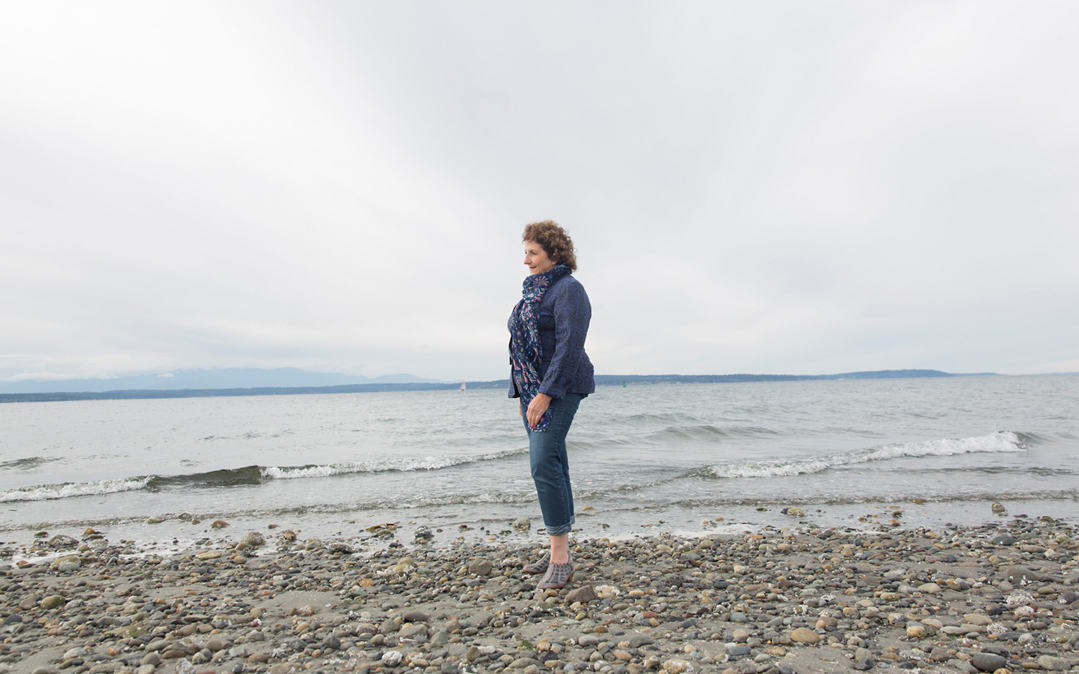
Alla Weinstein is proposing 100 floating offshore wind turbines at Morro Bay, California. | Photo by Mike Kane
Land-based wind in the United States is a fully mature industry, providing more than 74 GW of installed wind capacity, or 5.6 percent of all U.S. electricity. In 2015, California generated 11,856 gigawatt-hours—6 percent of the state's energy appetite—from land-based turbines. Future growth, however, is limited, because primo locations for wind energy in the state are already occupied, in protected areas, or too far from transmission lines. There is some room for future development from "repowering"—replacing yesterday's relatively small turbines with today's titans, which can tower upward of 300 feet, with blades sweeping an area the size of a football field. But once that's been done, if California wants more land-based wind energy, the state will have to import it from Wyoming or New Mexico.
There is plenty of room out in the Pacific Ocean, however, where the wind blows powerfully, unperturbed by lumpy landmasses. The National Offshore Wind Strategy report, jointly published last fall by the U.S. Department of Energy and the Department of the Interior, estimated that the Pacific coast has a technical potential resource capacity (that is, if turbines were placed everywhere possible) for an astronomical 245 GW, enough to power 55 million to 73 million homes. A 2009 study from Stanford University estimated the potential on California's coast alone to be up to 76 GW. "A single proposed wind farm near Cape Mendocino," it said, could "reduce California's current carbon-emitting electricity generation by 4 percent on an energy basis."
Here's the problem: The continental shelf off the West Coast drops very sharply (unlike off the eastern seaboard), leaving little room for offshore towers. Were California to rely solely on waters up to 50 meters deep that could accommodate traditional fixed towers, the Stanford researchers found, there might be potential for six to 11 GW. That's still a lot, but the effects on marine life would likely be major, and as with Cape Wind, the towers would inevitably interrupt treasured ocean views, making them politically toxic. Realistically, to harvest the ocean winds, you have to get away from the coast—and that means the turbines have to float.
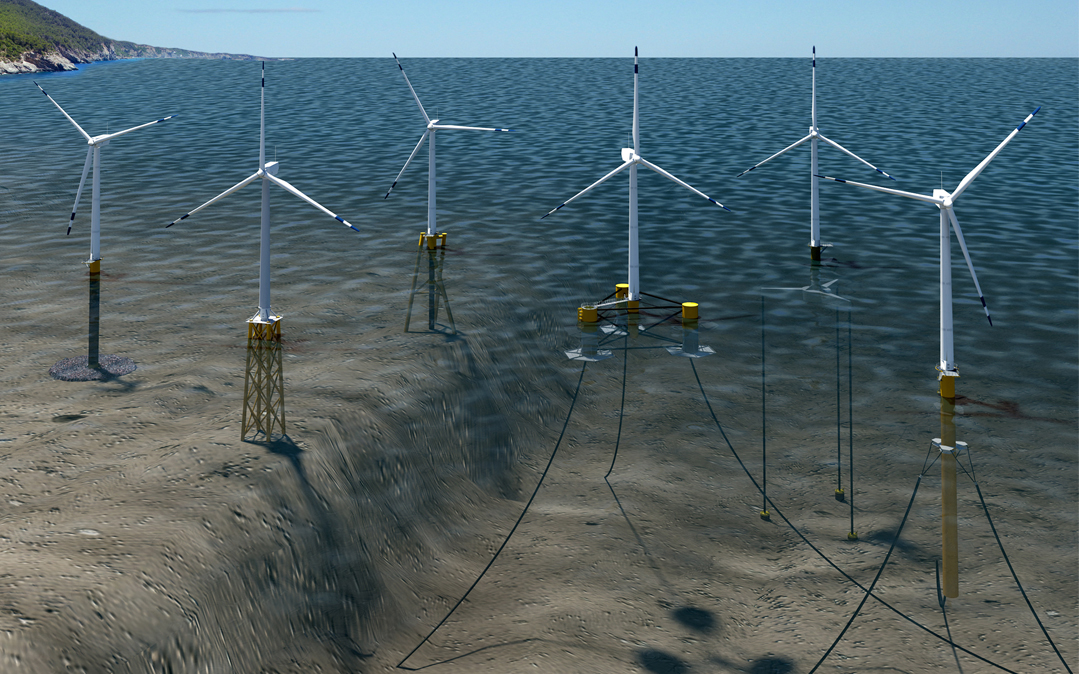
Fixed-bottom turbines are limited to shallow waters, but floating models can be sited far offshore. The anchors are installed without pile driving and can be removed easily when the project is over. | Photo by Joshua Bauer/NREL
Alla Weinstein believes that she's the one to make that happen. An emigre from the Soviet Union with a background in aviation engineering, Weinstein got involved in renewable energy "by accident." A chance meeting with the sons of a pioneering wave-energy system developer led her to found the AquaEnergy Group, which eventually won a permit to install a pilot array of its own systems in Makah Bay, Washington. "I said, 'Why not? It's good for the world. It's challenging.' And I needed a challenge."
One of Weinstein's next endeavors was Principle Power, which developed a triangular floating support structure for offshore turbines called WindFloat, one of two designs that have undergone successful sea trials in Europe. (The other is Hywind, by Norway's state energy company, Statoil.) Now her latest company, Seattle-based Trident Winds, is proposing the West Coast's first offshore wind farm in open ocean, roughly 33 miles off the central California coast.
Weinstein will need to be up for a challenge, because her Morro Bay Offshore project is an enormous undertaking. The 100 floating platforms would be spread over 55 square miles in waters 1,800 to 3,300 feet deep, moored to the ocean floor with giant anchors and cables. The platforms, each topped by a six-to-eight-megawatt turbine, would be interconnected, with a single undersea cable carrying their power to a conveniently shuttered power plant in the city of Morro Bay. The transmission lines connecting the plant to the grid are largely responsible for the project's location. California's most powerful and consistent offshore winds are far to the north, but electrical infrastructure on the sparsely populated North Coast is not well established, and Weinstein doesn't have time to wait for it. "I didn't want to deal with transmission lines," she says. "I was looking for in-place resources and infrastructure on shore."
The winds off the central California coast may not be as powerful, but they are still considerable. According to buoy data cited in Trident's application to the Bureau of Ocean Energy Management, turbines there might reliably generate far more energy than onshore turbines. By 2030, according to a study last year in Nature Energy, advances in height and rotor diameter should allow floating offshore turbines to generate nearly three times as much electricity as those onshore—up to nine megawatts.
Given the permits from 33 federal, state, and local agencies that Weinstein needs to obtain, the most important winds may be institutional, but for the moment those seem to be at her back. In October 2015, California governor Jerry Brown signed a bill mandating that the state obtain half of its energy from utility-scale renewable sources by 2030. That will require a large amount of new renewable capacity.
"You can't get there on solar alone," Weinstein maintains. The DOE/DOI National Offshore Wind Strategy report backs this up: "As more solar generation is added to the grid, it is able to meet an increasingly large portion of daytime load, but the grid also requires increasing amounts of other generation to ramp up to meet evening peaks as the sun goes down." Offshore wind, it notes, is strongest in the late afternoon into the evening, so "diversifying the portfolio with offshore wind could therefore help to reduce evening ramping requirements [when solar power declines but household demand rises] and ease the path toward 50 percent renewables by 2030."
In May 2016, Brown opened the door to offshore wind, asking Interior Secretary Sally Jewell for a joint task force to facilitate marine renewable energy. "New developments in wind technology," he wrote, "such as larger facilities that are not visible from land and present little to no adverse avian impacts will likely make projects more viable." Jewell agreed. By August, the Bureau of Ocean Energy Management had announced the initiation of a lease process with Trident, calling it a "major advance in developing wind energy offshore California."
♦
"Not visible from land." In a 2014 evaluation of the feasibility of developing wind energy off the central California coast, a team from Santa Barbara's Bren School of Environmental Science and Management surveyed a broad range of local stakeholders and found that "visual" was rated as the second-most-negative possible impact, trailing only "effect on bird species." Respondents to the Bren survey "overwhelmingly relayed a 'not in my backyard' reaction to possible wind farm locations."
Weinstein says that Trident's Morro Bay project will not be visible "if you are a regularly sized human being standing on the shore." That's assuming a tall turbine-hub height of 400 feet. (In fact, Weinstein says, ocean winds are so strong at sea level that towers need only be high enough so the blades can clear what's known as "greenwater"—the passing waves.) In any event, siting floating turbines far offshore could take the contentious issue of visual impact off the table.
The Center for Biological Diversity, the Natural Resources Defense Council, Audubon California, and Defenders of Wildlife expressed environmental concerns about the project in formal comments. All said that they are in favor of renewable energy, but not at any price. "Only by maintaining the highest environmental standards with regard to local impacts, and effects on species and habitat," the Center for Biological Diversity said, "can renewable energy production be truly sustainable."
With birds, the main potential problems are loss of habitat and collisions with turbine blades (a perennial problem at poorly placed onshore facilities). The CBD also cites lighting on the turbines, suggesting that it might attract birds to a messy end or otherwise disorient them. The NRDC and others share these concerns, but the NRDC points to European studies showing a relatively low mortality rate from birds colliding with offshore turbines. All agree that the subject needs further study—beginning with a baseline assessment of how many birds, and which species, frequent the distant site.
Andrea Copping, a senior program manager for coastal and marine waters at the Pacific Northwest National Laboratory in Seattle, spent several years examining the possible environmental effects of a demonstration floating wind farm off Coos Bay, Oregon, proposed by Principle Power. (The project was recently abandoned after the Oregon legislature declined to authorize state utilities to pay the high price that Principle was asking for its power.) The effect of turbines on birds, she says, is "something you can't conclusively determine until you have some of these things out there. That's because there's really no analogue, nothing comparable. There's nothing sticking 600 feet in the air and rotating that we can study."
With marine mammals, the primary issue is sound pollution—from pile driving, general operations of the turbines, and increased ship traffic. Stationary turbines require extensive pile driving to secure the foundations to the seafloor. But with floating platforms, Copping says, there are no foundations and hence no pile driving, and the ship traffic involved in the installation is minimal. "When you put in one of these floating platforms, you assemble all the parts at the quayside, including putting the tower and blades on in one piece. Then you tow it out with a single vessel. If something goes wrong and you have to do major maintenance, you tow it back in."
The other big concern with marine mammals is entanglement, although the mooring lines of floating platforms are attached at both ends and can't wrap around an animal the way that fishing gear might (see the illustration above). Weinstein says that floating platforms have long been in use in oil and gas production, and "we are not aware of any marine mammal that has tangled in the mooring lines of a floating offshore oil platform."
Sandy Aylesworth, the NRDC's oceans advocate in its San Francisco office, says that the mooring lines might still be a problem, depending on how slack they are. In addition, derelict fishing gear can snag on the lines, entangling sea creatures. On a larger scale, she says, "the Trident Winds project has a footprint of 55 square miles, with turbines half a mile apart. We just don't know how marine mammals would interact with a project of that scale."
Finally, there is the issue of the Morro Bay project's location, adjacent to the Monterey Bay National Marine Sanctuary and partially within the area nominated as the Chumash Heritage National Marine Sanctuary. The establishment of a new marine sanctuary would not preclude the wind farm's construction, but it would complicate it.
Weinstein appears unfazed. A novel undertaking the size of Morro Bay Offshore is destined to get a very thorough environmental review, which she welcomes. "The only thing I'd be asking," she says, "is that questions be based on fact and not on emotions." In her optimistic timeline, Trident will win development rights to the site in late 2017, and environmental review and other major permits will take up another five years. Construction would start as early as 2023 and commercial operation by 2025.
There are, of course, many possible bumps in a road that requires 33 separate permits (high among them is obtaining a purchase agreement from a California utility for power that—initially, at least—will be far more expensive than readily available solar or onshore wind). The environmental impact report may require extensive mitigations. The Bren School study concluded that Trident faces an uphill struggle, saying, "Disproportionate burdens exist on the 'first movers' of offshore wind development in central California." Why take that on?
Weinstein laughs. "Someone has to do it," she says, with just the trace of a Russian accent. "If we don't have someone doing it first, then guess what? There would be nothing."
This article appeared in the January/February 2017 edition with the headline "High-Seas Power."
 The Magazine of The Sierra Club
The Magazine of The Sierra Club
